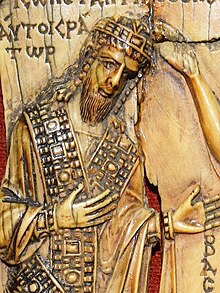
Back Konstantyn VII van Bisantium Afrikaans Konstantin VII. ALS Constantín VII AN قسطنطين السابع Arabic قسطنطين السابع ARZ Constantín VII AST یئدینجی کونستانتین AZB Канстанцін VII Парфірародны Byelorussian Константин VII Багренородни Bulgarian Konstantin VII Porfirogenet BS
| Constantine VII | |||||||||
|---|---|---|---|---|---|---|---|---|---|
| Emperor and Autocrat of the Romans | |||||||||
 Constantine VII crowned by Christ, detail of an ivory plaque, Pushkin Museum, AD 945 | |||||||||
| Byzantine emperor | |||||||||
| Reign | 6 June 913 – 9 November 959 (alone from 27 January 945) | ||||||||
| Coronation | 15 May 908 | ||||||||
| Predecessor | Alexander | ||||||||
| Successor | Romanos II | ||||||||
| Co-emperors | Romanos I (920–944) Christopher (921–931) Stephen and Constantine (924–945) Romanos II (945–959) | ||||||||
| Born | 17 May 905 Constantinople | ||||||||
| Died | 9 November 959 (aged 54) Constantinople | ||||||||
| Spouse | Helena Lekapene | ||||||||
| Issue | Romanos II Theodora | ||||||||
| |||||||||
| Dynasty | Macedonian dynasty | ||||||||
| Father | Leo VI | ||||||||
| Mother | Zoe Karbonopsina | ||||||||
Constantine VII Porphyrogenitus (Ancient Greek: Κωνσταντῖνος Πορφυρογέννητος, Kōnstantinos Porphyrogennētos; 17 May 905 – 9 November 959) was the fourth Byzantine emperor of the Macedonian dynasty, reigning from 6 June 913 to 9 November 959. He was the son of Emperor Leo VI and his fourth wife, Zoe Karbonopsina, and the nephew of his predecessor Alexander.
Most of his reign was dominated by co-regents: from 913 until 919 he was under the regency of his mother, while from 920 until 945 he shared the throne with Romanos Lekapenos, whose daughter Helena he married, and his sons. Constantine VII is best known for the Geoponika (τά γεοπονικά), an important agronomic treatise compiled during his reign, and three, perhaps four, books; De Administrando Imperio (bearing in Greek the heading Πρὸς τὸν ἴδιον υἱὸν Ῥωμανόν),[1] De Ceremoniis (Περὶ τῆς Βασιλείου Τάξεως), De Thematibus (Περὶ θεμάτων Άνατολῆς καὶ Δύσεως), and Vita Basilii (Βίος Βασιλείου), though his authorship of the Vita Basilii is not certain.[2][3]
The epithet porphyrogenitus alludes to the Purple chamber of the imperial palace, decorated with porphyry, where legitimate children of reigning emperors were normally born. Constantine was also born in this room, although his mother Zoe had not been married to Leo at that time. Nevertheless, the epithet allowed him to underline his position as the legitimate son, as opposed to all others, who claimed the throne during his lifetime. Sons born to a reigning Emperor held precedence in the Eastern Roman line of succession over elder sons not born "in the purple".
Cite error: There are <ref group=lower-alpha> tags or {{efn}} templates on this page, but the references will not show without a {{reflist|group=lower-alpha}} template or {{notelist}} template (see the help page).
- ^ Moravcsik 1967.
- ^ Logos 2019a, pp. 10, 10B.
- ^ Logos 2019b, pp. 10–12.